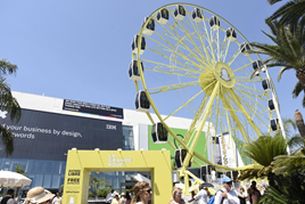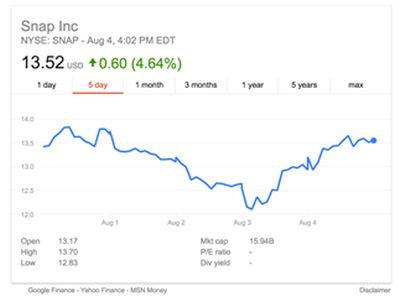
Snapchat’s Cheeky Wheel of Fortune: Augmented Reality’s Fluctuating Forecasts

At the 2017 Cannes Lions Festival, a giant yellow Ferris wheel stood perched at the foot of the iconic red carpet leading to Cannes’ Palais des Festivals. Dominating the skyline, this temporary Snapchat installation served as a potent symbol of the power of technology to superimpose its magic over any scene it surveys. The placement was no accident: looming directly over the convention centre's primary entrance, it was a spectacle impossible to ignore, and over the course of the week the wheel generated endless conversations and reactions from a wide range of industry figures. But regardless of the opinions it provoked, it’s hard to dispute that the Snapchat Wheel offered up a fantastic analogy depicting the promise of augmented reality.
Augmented reality, or AR, overlays digital imagery over the real world in order to build a new composite mixture of physical reality blended with computer-generated wizardry. AR puts pixelated computer art on top of your pictures. Forcing thousands of Cannes Lions delegates to view the facade of the Palais filtered through the Snapchat Wheel’s bright yellow spokes was a coup of sorts for a company banking on the growing popularity of its AR photo lenses. The brazen positioning of this classic amusement park ride epitomised the new order encroaching onto advertising’s traditional hallowed grounds, and marked the latest chapter in the long, winding saga of tech companies jockeying for position to claim their rightful place at the world’s largest gathering of marketing professionals.
Snapchat’s cheeky hijacking of the Palais in 2017 marked a clear shift from how the company has navigated the Cannes Lions Festival in recent years. In 2016, Snapchat CEO Evan Spiegel spent the week of Cannes Lions playing hard-to-get, holding court at a private compound just outside the festival grounds, and reportedly only welcoming advertising executives to meet with his company on an invitation-only basis. Although Snapchat ran several big, highly visible tactical ads at Cannes in 2016, its measured distance from the festival was conspicuous, since competitors like Facebook and Instagram were busy ramping up their own presence and delegations. But much has changed in a year. Playing coy is no longer an option for a company with Snapchat’s growing clout, global ambitions, and wavering outlook.
In March of 2017 Snap Inc.’s highly anticipated IPO netted the company a lucrative valuation of $34.7 billion USD. The wave of euphoria that surrounded Snap Inc.’s entry into the stock market quickly ebbed, as Snap’s share price dropped from a high of $27 USD on its second day of trading to the low of $12.10 that it hit at the beginning of August 2017. These fluctuations are the result of a multitude of factors, all of which have contributed to the company’s market cap declining by more than 50% in four months. Snap’s initial valuation of $34.7 billion USD has since been halved, to the $15.94 billion USD where it stands today. This kind of volatility is not uncommon for new tech IPOs, but Snap stands out as a cautionary story with unique risks for investors. This company may well prove to be a juggernaut in the long run, but in 2017, Snap is facing some distinct growing pains.

Snap’s issues are manifold. In April an unsubstantiated report alleged that Snap CEO Evan Spiegel stated in a private conversation with a disgruntled former employee that Snapchat “is only for rich people”, and that he wasn’t interested in expanding to 'poor' markets like India, which the company was quick to refute as 'ridiculous.' However, in today’s meme-heavy, fake-news-friendly online environment, the allegation led to a PR nightmare as the Internet took the accusation and ran with it, regardless of its veracity. A #BoycottSnapchat campaign was instigated by irate Indians who felt slighted by the idea that India wasn’t 'rich enough' to merit Snap’s focus. In the furor over the disputed comment, the company lost billions in value, which occurred just as Snap’s earnings reports and financials were coming under increased scrutiny from investors seeing the workings of the company publicly for the first time. Snap's corporate governance structure has been flagged as unorthodox and controversial, with a non-voting share structure that gives the company’s management a rare and potentially dangerous level of autonomy and independence. All of this has led to investor anxiety surrounding Snap, but what’s truly been eroding confidence in the company is the way Snap’s competition has spent the last year feasting on the app’s proprietary features.
In August 2016, Instagram rolled out its 'Stories' feature, in what WIRED Magazine called “a brazen ripoff of Snapchat.” In the year since then, Instagram has considerably eaten into Snap’s market share, steadily increasing its user numbers and diversifying its offerings, even going so far as to roll out its own selfie filters that put AR dog ears and top hats over people’s pictures. By replicating Snapchat’s most popular features, Instagram has been siphoning Snap’s revenues. Snap’s future will depend on how it responds to the way other companies are currently cannibalising its very essence.
There are also larger issues at play that reflect how the investor class currently regards the entire budding AR and VR industry. Even though there’s no shortage of glowing forecasts concerning mixed reality as a growth sector, skeptics still note that the cost of embracing this technology presents a clear barrier to entry for most of the planet’s population. Both VR and AR still seem tantalisingly out of reach for many, and no one is entirely sure what the world will look like by the time these technologies become universally accessible and commonplace. The consensus seems to be that we’re still a few years away from mass adoption, which leads to pointed questions. In a few years, will Snapchat be the unstoppable creative juggernaut that ushers people into the world of mixed reality? Will Snap’s camera and its many lenses be the primary trusted interface that grants people access to this hybrid universe of digitally-enhanced reality? Or will it be swallowed by some other giant platform like Google or Amazon? Who will be the first to truly capture the entire planet’s popular imagination around this new emerging technology?
Snapchat wants to get there first. Regardless of the struggles it has faced over the last year, the company is still an indisputable social media powerhouse, and it’s busy developing new products and services that it believes will make it a vital player for decades to come. Just this month, the company has released a series of unique digital backdrops and quirky vocal filters that give people the capability to doctor their own images and sounds. These kinds of evolving in-app offerings have proven to be hugely popular amongst Snapchat’s 160 million+ daily user base. The brand’s new Spectacles, beautifully designed Bluetooth-linked glasses that take pictures and record high quality video, have been widely praised as “ridiculously fun,” and Spectacles won a slew of Lions at Cannes in 2017 across several categories. Clearly this is a company to watch.

But the chorus of critics and skeptics is growing louder. There is no guarantee that this groundbreaking, innovative company will survive the leaps to come. All its magic may prove to be ephemeral. So perhaps it’s time, before something new turns up, to download the free Snapchat app and spend some time tooling around in it. Take some silly pictures. Listen to your children giggle as the app throws cat ears and rabbit whiskers and a kitty tongue onto their faces, or gives them a shiny halo or Heisenberg’s goatee and pork pie hat. Marvel at how this app turns your camera into a funhouse carnival mirror. Take a look at their “stories” feature, which they believe will be the driving force increasing their revenues, as brands will seek to use Snapchat as an advertising platform by sponsoring stories around curated content and picture and video streams. Is this app worth your time? Maybe. Or maybe you’re a staunch skeptic. Maybe you still think of Snapchat as an app only for specific kinds of young people. Maybe you don’t like the idea of putting a filter over reality. Or maybe you just don’t have any free space on your phone.
There’s nothing wrong with preferring the old way, the proud Palais back when it was unadorned, without any gaudy structures in front of it blocking your view. But all of us have to come to terms with the new mixed reality that’s knocking at the door. As so many delegates at Cannes Lion 2017 discovered this year, even if you take a step back, and even if you prefer the landscape the way it used to be, there’s still an insolent yellow glare creeping into the frame of the picture you want to take.












